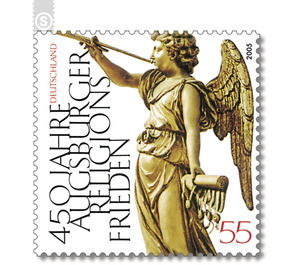winter - Germany / Federal Republic of Germany 2008 - 55 Euro Cent
Theme: Art & Culture
| Country | Germany / Federal Republic of Germany |
| Issue Date | 2008 |
| Face Value | 55.00 |
| Perforation | K 13 3/4 |
| Stamp Type | Postage stamp |
| Item Type | Stamp |
| Chronological Issue Number | 2573 |
| Chronological Chapter | GER-BRD |
| SID | 827194 |
| In 43 Wishlists | |
In 1517, Martin Luther initiated the Reformation with his criticism of the Catholic Church, which from then on developed into a movement for both church and political freedom. She threatened to split the unity of the Roman Catholic Church and the Holy Roman Empire of the German Nation. Therefore, Emperor Charles V called for the Reichstag in Augsburg. His representative, King Ferdinand I, agreed with the voting members of the Reichstag, the Reichsstände, on September 25, 1555, on a settlement that enabled the coexistence of Catholic and Protestant Christians as the Reichsgesetz. It went down in history as the »Augsburg Religious Peace«. The agreement was a political compromise of world historical significance. It was the first time that the Protestant faith was recognized by the state as an independent denomination and made possible a peaceful coexistence, since the text avoided the codification of a single "true faith". According to the law, the subjects of the respective denomination of their sovereign should also belong. For this stands the Latin formula "cuius regio, eius religio" (in English: "whose territory, its faith"). Subjects who did not want to take over the faith of their sovereign, were allowed to emigrate. This was an extremely modern arrangement for the time. The Augsburg Peace of Religion ended the religious dispute for a short time, but this broke out again in 1618 with the Thirty Years' War and ended only in 1648 with the Peace of Westphalia. The Augsburg Peace of Religion can also be seen as a domestic victory of the territorial rulers over the central governmental power of the emperor, whose universal claim to power thus ends


